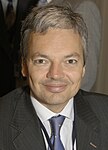Belgian general election, 2007
|
|
|||||||||||||||||||||||||||||||||||||||||||||||||||||||||||||||||||||||||||||||||||||||||||||||||||||||||||||
|---|---|---|---|---|---|---|---|---|---|---|---|---|---|---|---|---|---|---|---|---|---|---|---|---|---|---|---|---|---|---|---|---|---|---|---|---|---|---|---|---|---|---|---|---|---|---|---|---|---|---|---|---|---|---|---|---|---|---|---|---|---|---|---|---|---|---|---|---|---|---|---|---|---|---|---|---|---|---|---|---|---|---|---|---|---|---|---|---|---|---|---|---|---|---|---|---|---|---|---|---|---|---|---|---|---|---|---|---|---|
|
|||||||||||||||||||||||||||||||||||||||||||||||||||||||||||||||||||||||||||||||||||||||||||||||||||||||||||||
|
|
|||||||||||||||||||||||||||||||||||||||||||||||||||||||||||||||||||||||||||||||||||||||||||||||||||||||||||||
|
All 150 seats in the Chamber of Representatives 40 of 71 seats in the Senate respectively 76 and 36 seats needed for a majority |
|||||||||||||||||||||||||||||||||||||||||||||||||||||||||||||||||||||||||||||||||||||||||||||||||||||||||||||
|
|||||||||||||||||||||||||||||||||||||||||||||||||||||||||||||||||||||||||||||||||||||||||||||||||||||||||||||

Colours denote the winning party in each electoral district, as shown in the table of results.
|
|||||||||||||||||||||||||||||||||||||||||||||||||||||||||||||||||||||||||||||||||||||||||||||||||||||||||||||
|
|||||||||||||||||||||||||||||||||||||||||||||||||||||||||||||||||||||||||||||||||||||||||||||||||||||||||||||
Verhofstadt III Government (interim)
The 2007 Belgian federal election took place on Sunday 10 June 2007. Voters went to the polls in order to elect new members for the Chamber of Representatives and Senate.
Eligible voters were Belgian citizens 18 years and older. There was a legal electoral threshold of 5% for political parties to meet to receive representation, but in several election districts the real electoral threshold is higher than the legal, due to the small number of seats to be elected in the particular district. The 150 members of the Chamber of Representatives were elected from 11 electoral districts. The 40 Senate members were elected from the Dutch (25) and Francophone (15) electoral colleges.
Of the Flemish parties, the alliance of Christian Democratic and Flemish party (CD&V) and the New-Flemish Alliance (N-VA) received an increased share of the vote from the previous election, held in 2003. The CD&V/N-VA list was headed by Yves Leterme, and became the largest political formation in Belgium, thus leading the coalition talks for a new government. Flemish Interest (Vlaams Belang) received more votes than in the previous election, but lost one seat. Green! was able to return to parliament and newcomers List Dedecker (Lijst Dedecker) surprised most by immediately grabbing six seats, including one in the Senate. Prime minister Guy Verhofstadt's "purple coalition," consisting of his Open Flemish Liberals and Democrats (Open VLD) alliance list and Socialist Party – Different (SP.A/SPIRIT), was punished in the election, with the SP.A/SPIRIT alliance losing somewhat more than Verhofstadt's Open VLD alliance. The day after the election, Verhofstadt handed in the resignation of his government to King Albert II. SP.A leader Johan Vande Lanotte resigned from his leadership position as well that day.
...
Wikipedia






